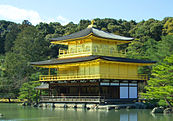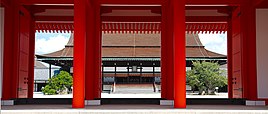
Back Kyoto ACE Киото ADY Kioto Afrikaans Kyōto ALS ክዮቶ Amharic Kyoto AN Hēancyō ANG كيوتو Arabic ܩܝܘܛܘ ARC كيوتو ARZ
Kyoto
京都市 | |
|---|---|
From top left: Kiyomizu-dera, Bamboo Forest of Arashiyama, Kinkaku-ji, Dry garden of Ryōan-ji, Katsura Imperial Villa, Senbon torii gates of Fushimi Inari-Taisha, Heian Shrine and Kyoto Imperial Palace | |
 | |
 Location of Kyoto in Kyoto Prefecture | |
| Coordinates: 35°0′42″N 135°46′6″E / 35.01167°N 135.76833°E | |
| Country | |
| Region | Kansai |
| Prefecture | Kyoto Prefecture |
| Founded | 794 |
| Government | |
| • Type | Mayor–council |
| • Body | Kyoto City Assembly |
| • Mayor | Kōji Matsui |
| Area | |
| • Designated city | 827.83 km2 (319.63 sq mi) |
| Highest elevation | 971 m (3,186 ft) |
| Lowest elevation | 9 m (30 ft) |
| Population (October 1, 2020)[1] | |
| • Designated city | 1,463,723 |
| • Rank | 9th, Japan |
| • Density | 1,800/km2 (4,600/sq mi) |
| • Metro | 3,783,014 |
| Time zone | UTC+9 (Japan Standard Time) |
| - Tree | Weeping Willow, Japanese Maple and Katsura |
| - Flower | Camellia, Azalea and Sugar Cherry |
| Website | city.kyoto.lg.jp |
| Kyoto | |||||||
|---|---|---|---|---|---|---|---|
"Kyoto" in kanji | |||||||
| Japanese name | |||||||
| Kanji | 京都 | ||||||
| |||||||
Kyoto (/ˈkjoʊtoʊ/;[3] Japanese: 京都, Kyōto [kʲoꜜːto] ), officially Kyoto City (京都市, Kyōto-shi, [kʲoːtoꜜɕi] ), is the capital city of Kyoto Prefecture in the Kansai region of Japan's largest and most populous island of Honshu. As of 2020[update], the city had a population of 1.46 million, making it the ninth-most populous city in Japan. More than half (56.8%) of Kyoto Prefecture's population resides in the city. The city is the cultural anchor of the substantially larger Greater Kyoto, a metropolitan statistical area (MSA) home to a census-estimated 3.8 million people. It is also part of the even larger Keihanshin metropolitan area, along with Osaka and Kobe.
Kyoto is one of the oldest municipalities in Japan, having been chosen in 794 as the new seat of Japan's imperial court by Emperor Kanmu. The original city, named Heian-kyō, was arranged in accordance with traditional Chinese feng shui following the model of the ancient Chinese capitals of Chang'an and Luoyang. The emperors of Japan ruled from Kyoto in the following eleven centuries until 1869. It was the scene of several key events of the Muromachi period, Sengoku period, and the Boshin War, such as the Ōnin War, the Honnō-ji Incident, the Kinmon incident, and the Battle of Toba–Fushimi. The capital was relocated from Kyoto to Tokyo after the Meiji Restoration. The modern municipality of Kyoto was established in 1889. The city was spared from large-scale destruction during World War II and, as a result, its prewar cultural heritage has mostly been preserved.
Kyoto is considered the cultural capital of Japan and is a major tourist destination. The agency for cultural affairs of the national government is headquartered in the city. It is home to numerous Buddhist temples, Shinto shrines, palaces and gardens, some of which have been designated collectively as a World Heritage Site by UNESCO. Prominent landmarks include the Kyoto Imperial Palace, Kiyomizu-dera, Kinkaku-ji, Ginkaku-ji, and Kyoto Tower. The internationally renowned video game company Nintendo is based in Kyoto. Kyoto is also a center of higher learning in the country, and its institutions include Kyoto University, the second-oldest university in Japan.
- ^ a b "2020 Population Census". Archived from the original on July 16, 2022. Retrieved July 16, 2022.
- ^ "京都都市圏の範囲及び取組" (in Japanese). 京都都市圏自治体ネットワーク. Archived from the original on April 24, 2017. Retrieved July 16, 2022.
- ^ "Kyoto | Definition of Kyoto by Merriam-Webster". Merriam-Webster. Archived from the original on August 3, 2020. Retrieved May 7, 2020.












